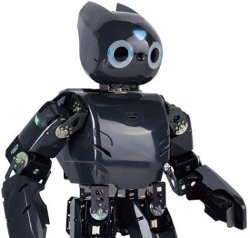Jan 19 2011
The DARwin OP, Dynamic Anthropomorphic Robot with Intelligence, Open Platform from Virginia Tech was developed for use in education and outreach. It is completely open source from software to hardware, PC based and can run several operating systems from Windows to Linux.
Robotis, a Seoul Korea company with offices in Irvine California, is the business partner of this research, and offers the hardware and cad assembly with fabrication manuals on the internet.
 DARwin OP
DARwin OP
The little 18 inch, 6 pound robot was showcased at IEEE’s Humanoids 2010 conference recently. Its development was partnered by the National Science Foundation and Virginia Tech’s Robotics & Mechanisms Laboratory (RoMeLa) team.
They worked with Purdue University and the University of Pennsylvania's General Robotics, Automation, Sensing and Perception (GRASP) Laboratory that integrated computer science, electrical engineering, and mechanical engineering.
Earlier versions have been seen in RoboCup competitions. RoMeLa studies robot movement and autonomous behavior under the tutelage of Dr. Dennis Hong. They study mechanical design, kinematics, dynamic bipedal gaits, ZMP (zero moment point) control, and vision tracking for playing soccer.
The version 0 tried to control a 21 DOF (degree of freedom) humanoid robot, beginning with the Cycloid robot from Robotis and the Dynamixel DX-117 motor to monitor movement. DARwin I was developed with the same 21 degrees of freedom, 4 force sensors on each foot, a 3 axis rate gyro, a 3 axis accelerometer, and space for a computer and batteries.
The links were fabricated from bent sheet aluminum. The earlier version was unstable and needed a series of stances to walk and tripped when faced with obstacles. The latest version has overcome the turtle syndrome of falling flat and being unable to rise.